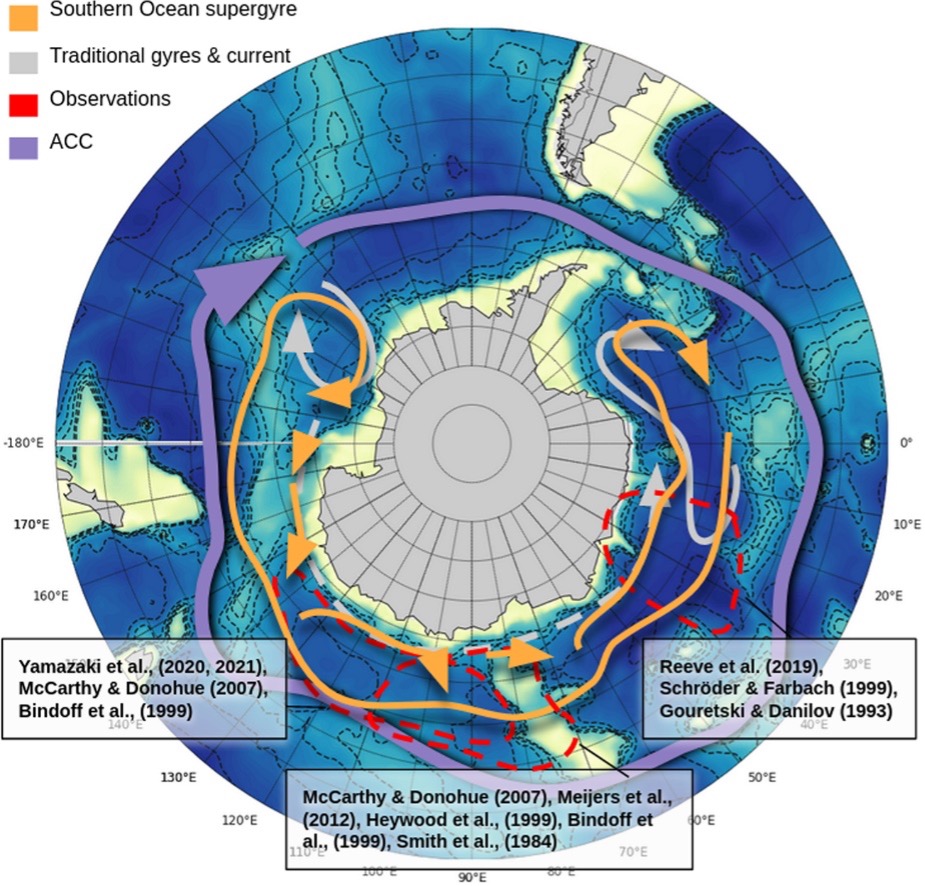The discovery is revolutionary: researchers have used an advanced form of artificial intelligence (AI) combined with physical oceanography to suggest the existence of a “supergyre” or “super ocean current” in the Southern Ocean. This discovery could have major implications for a better understanding of this remote and hitherto little-measured Southern Ocean, which nevertheless plays a major role in our planet’s climate system.
The Southern Ocean, a major connection point for the climate
The ocean acts like a gigantic thermostat for the Earth. It transports, stores and redistributes the Earth’s energy from the equator to the poles thanks to the dynamics of its ocean currents. On both large and small scales, ocean circulation plays a crucial role in this process, particularly in the Southern Ocean.
The Southern Ocean is the only ocean that connects the three main ocean basins of the Atlantic, Pacific and Indian Oceans. It is driven by the Antarctic Circumpolar Current, the most powerful ocean current in the world, which surrounds the entire Antarctic continent. The Antarctic Circumpolar Current has a significant impact on marine biodiversity, acting as a natural barrier that isolates Antarctic fauna and contributes to the unique diversity of species in this region.
A story of gyres that go round and round
Traditionally, scientists consider that beyond this great Antarctic circumpolar current, the Southern Ocean is driven by two main gyres: the Weddell gyre and the Ross gyre, named after the two seas in the region. These two large circular structures dominate ocean circulation in the Southern Ocean, but their dynamics are complex and much remains to be discovered about how they work and their variability in time and space.
To understand what a gyre is, imagine a system of ocean currents that circle the ocean. In the northern hemisphere, these gyres turn clockwise, while in the southern hemisphere they turn anticlockwise. Set in motion by surface winds, these gyres are important not only because they help to distribute heat between the equator and the poles, but also because they play a part in the upwelling of deep, cold ocean waters to the surface.
In the North Atlantic, the Pacific and the Indian Ocean, the gyres are clearly and naturally defined by the western or eastern continental boundaries of the basins. In contrast, the gyres of the Southern Ocean do not have such clearly defined boundaries, as this ocean is shaped like a ring and is not bounded by land. The Weddell and Ross gyres are therefore part of a complex global ocean circulation in this region, which is undoubtedly more difficult to understand than elsewhere.
A super gyre with an essential role to play in climate and biodiversity
Recently, a team of scientists used artificial intelligence to propose a new perspective on ocean circulation in this ocean: the existence of not two but a single quasi-circumpolar ‘supergyre’, whose role in climate is underestimated.
Using new artificial intelligence (AI) tools and a machine learning algorithm called THOR, researchers have identified the factors that govern ocean circulation in the Southern Ocean. They propose the existence of a single supergyre in the Southern Ocean, a quasi-circumpolar structure that encompasses and links the Ross and Weddell subgyres into a single supercurrent around the Antarctic continent.

The grey arrows indicate the individual traditional gyres. The yellow arrows indicate the area covered by the supergyre. The purple arrow is the approximate location of the circumpolar current. The red dotted lines indicate the approximate areas where observations were collected that support the supergyre framework.. © M. Sonnewald et al., 2023
AI has enabled researchers to understand that the characteristics of the seabed play a key role in the formation of this supergyre. The topography acts as an effective boundary along the Antarctic Circumpolar Current, stimulating the upwelling of water in the face of obstacles on the seabed. In other words, cold, dense water from the ocean floor is pushed towards the surface when the Antarctic Circumpolar Current encounters an obstacle, such as a seamount. Once at the surface, this cold, nutrient-rich water can support marine life and help regulate the climate by absorbing carbon dioxide from the atmosphere.
What does AI really bring to oceanography?
These results are a concrete example of how AI and new technologies can be used to improve our understanding of the ocean. By using machine learning techniques, scientists can analyse large amounts of data and identify patterns that would otherwise be difficult to detect.
In the case of this study, AI opens up a new perspective on ocean circulation in the Southern Ocean, which could have significant implications for our understanding of its role in the climate system. AI could become a new tool to help scientists identify key areas to monitor, determine where and how to collect data more accurately, or improve climate models by providing a more accurate representation of the details of ocean circulation in the Southern Ocean.
Source : Sonnewald, M., Reeve, K.A. & Lguensat, R. A Southern Ocean supergyre as a unifying dynamical framework identified by physics-informed machine learning. Commun Earth Environ 4, 153 (2023). https://doi.org/10.1038/s43247-023-00793-7
